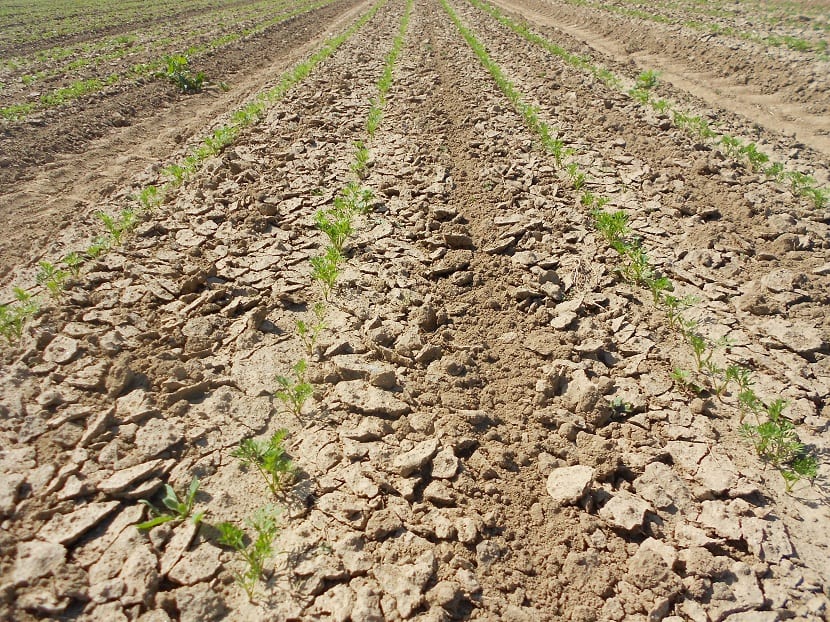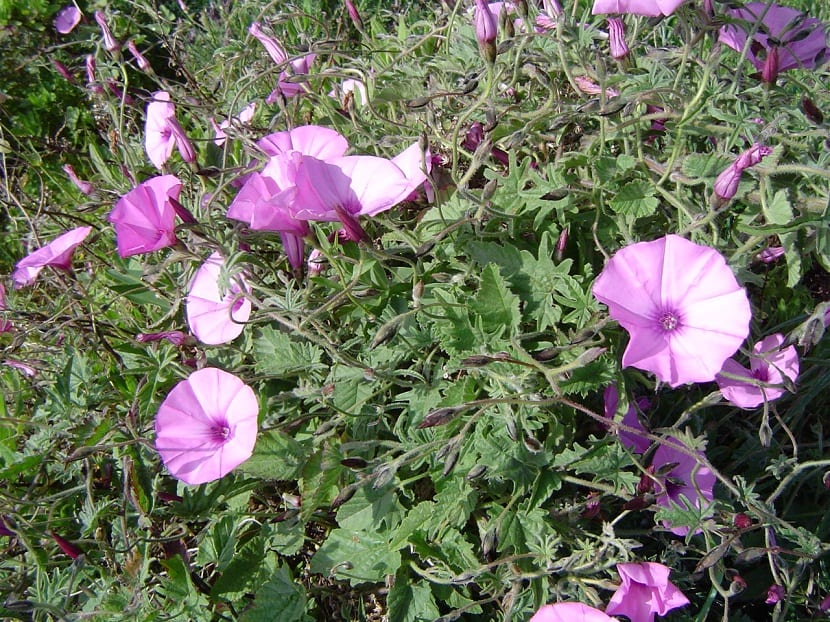
La Convolvulus althaeoides is a plant of the family ConvolvulaceaeHerbaceous, perennial and rustic general characteristics. From the etymological point of view, the name of the genus derives from the Latin convolvere which means to entangle or wrap, which is the characteristic feature of this plant, being an invasive herbaceous, which spreads to other plants, hindering their development to the point to cause their desiccation.
Features Convolvulus althaeoides
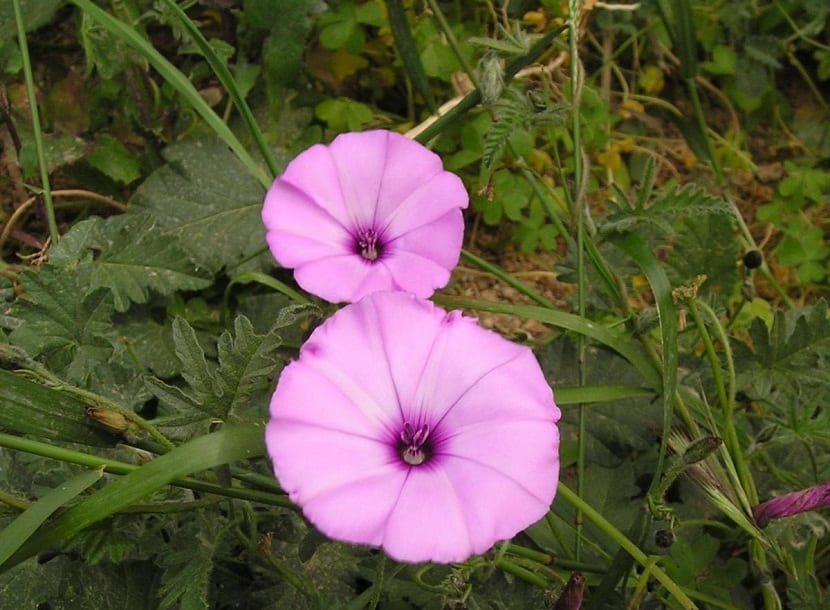
This creeping species can reach two meters in height, being of climbing habit. It has long roots and its stems are extended, thin, ductile, semi-woody and completely covered with a thick bluish fur.
With leaves in alternate position, thin, of a silvery greenish and petiolate color, the lower leaves can be heart-shaped or triangular and with serrated edges; while its upper laminae are divided into unequal segments.
In the month of April it is covered with abundant flowers, solitary or paired, large, located in the axils of the leaves supported by long tails. The corolla is funnel-shaped and has a more intense pink color in its center..
The trachea is made up of toothed, pointed and obtuse sepals and its flowers close when darkness falls. The fluorescence extends to the month of June. The pollination process of this plant is favored by bees, butterflies and other insects. Its fruit is spherical and acuminate.
Origin and habitat
El Convolvulus althaeoides It is native to the Mediterranean, its distribution is limited to the southern regions of Europe, the Canary Islands and the north of the African continent. Its presence is common in the southeast of the Iberian Peninsula. It tolerates well heights of up to 600 meters above sea level.
There are various creeper species in Europe, eight of which are in Malta. Some of these species and because of their invasive habit are considered true pests that disturb other plants. Nevertheless, have the great advantage that in summer, while other plants show a dry appearance, this one maintains its color.
Plantation
This plant adapts to all types of soil, but well-drained, nutrient-rich soils are perfect for its growth. If you want the best for their development, consider placing it in soft, alkaline soil. In favorable conditions it does not require special care and to prevent the possible appearance of fungi and with it, the rotting of the plant, you must avoid watering it if the soil is still wet.
Regarding the right climate, hot climates and good sun are recommendedAlthough it is capable of withstanding temperatures down to -10º C. It does not tolerate excess humidity or strong winds, so it is important to keep it protected from drafts. Flowering of this species occurs between spring and summer.
This plant tolerates drought, however and during the warm months you can water it regularly and in the cold season you should reduce watering considerably, because the plant does not support moisture.
If you plan to use fertilizers, make sure they are natural or specific products for this type of plant. You must apply the fertilizer annually and always keep in mind that you should not exceed three cycles, because although it is true, you can obtain a beautiful foliage, you would also delay its flowering.
Propagation
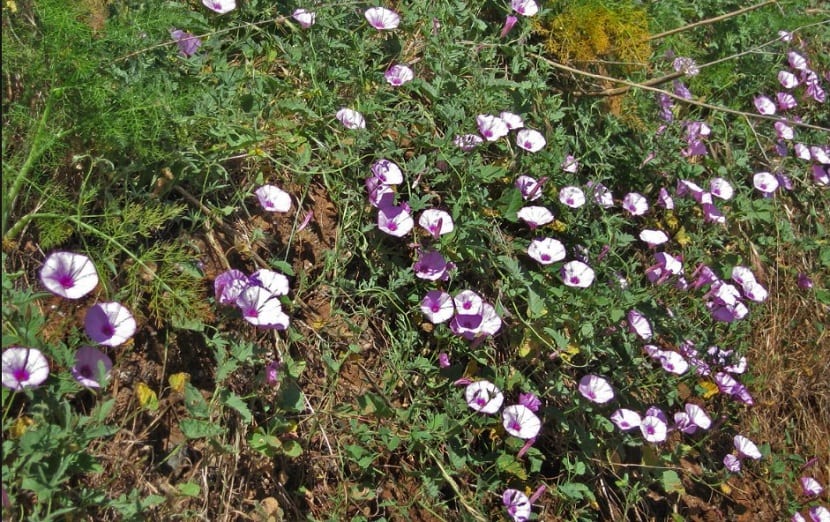
This plant can be propagated by seed or cut, The latter can be done during the spring or autumn, once the flowering period is over. The sowing of its seeds is carried out in spring, place the seeds in a box at a cool temperature.
You are going to observe that when the suckers develop, they show a solid root system, it is the right time to plant in the ground. Often, This vine grows spontaneously.
You can also reproduce the plant by cuttings. For it, it is required to take advantage of a part of the stem or a shoot from the base and for best results, the cut should be done in late winter or early fall. On the other hand, we inform you that the pruning of this species is essential to ensure optimal growth and beautiful foliage.
If you prefer to plant it in pots, then prepare a mixture that contains two parts of fertile soil and one part of peat, add volcanic sand and stone, surely this will make her grow generously.
In case you need to replant it, do it only if the space where it is planted is insufficient. If you are one of those who prefers to plant in the open field, then you should do it between the months of April and May, remember that this species adapts to almost all types of soilas long as it is well drained and sunny.
Uses
This plant is present in many balconies and domestic gardens, the semblance it offers is ideal for use in hanging baskets. However, remember that it has a rapid growth that can cause discomfort at home.
So that you must prune to maintain good foliage and prevent it from invading other ornamental plants in your garden. Its tolerance to cold makes it useful for keeping the garden decorated all year round and it is ideal for building flower beds and borders.
There is news that This vine has been used as a purgative since ancient timesIts laxative properties derive from its strong content of saponins in the sap, which spreads through roots and leaves. In Germany its leaves are used in the treatment of excess vaginal discharge.
However its use at home is not recommended If you do not have enough knowledge of natural medicine, due to the abuse of its use, it can be toxic. The drying and preservation of its leaves serves to preserve its medicinal properties for a long time.
The vine works to purify the intestine, used in cases of liver failure, serves as an analgesic for the neurovegetative system and its leaves have antipyretic properties.
Diseases and pests
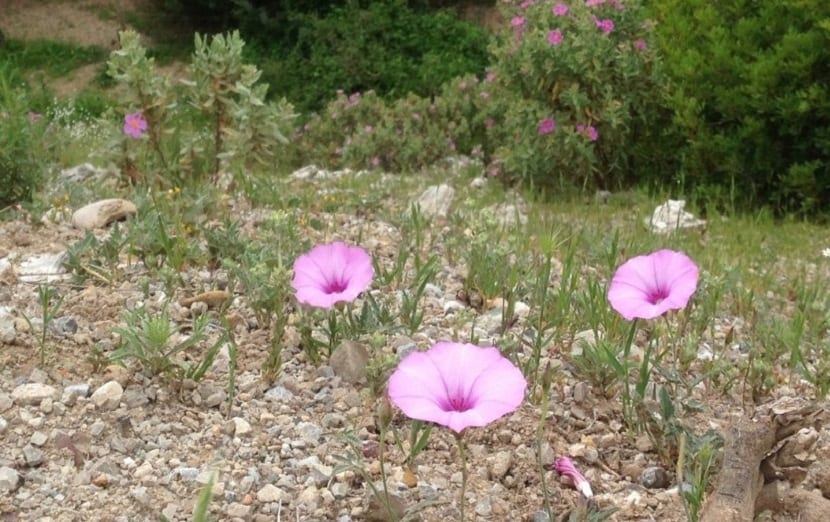
All the Convolvulus althaeoides They are usually attacked by different types of fungi or fungal parasites. Mold is manifested by the appearance of lesions and yellowish spots on the underside of the leaves; as well as in the stem of the plant.
Diseases caused by fungi must be treated in time and to prevent the plant from dying. To do this, the affected leaves can be cut and specific products applied for this type of disease and if they are natural, the better. It should be taken into account that the vine does not support the stagnation of fluids, as this can lead to the rotting of its roots.
This species can grow spontaneously in the field or at home, infecting gardens, while hindering the development and proper growth of other plants, yes, it must be said that this plant is not as harmful as other species that climb on the flat.
It is also harmful, so in case of invasion it is necessary to eliminate it, using different specific products., paying attention to toxic effects and natural farming techniquessuch as false seeding and weed control.
